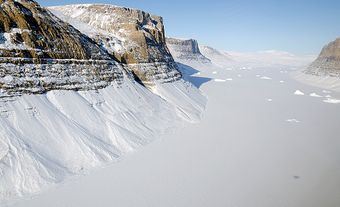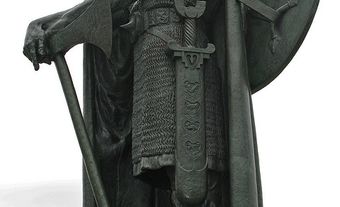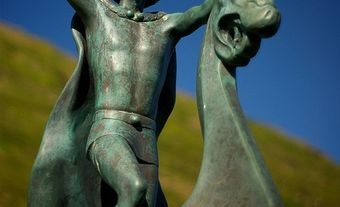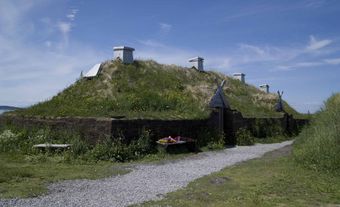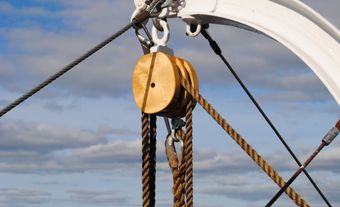Erik the Red (Eiríkr rauða in Old Norse and Eiríkur rauði in modern Icelandic, a.k.a. Erik Thorvaldsson), colonizer, explorer, chief (born in the Jæren district in Norway; died c. 1000 CE at Brattahlid, Greenland). An Icelandic settler of modest means who was exiled for his involvement in a violent dispute, Erik the Red rose in status as he explored Greenland and founded the first Norse settlement there. One of his sons, Leif Eriksson, led some of the first European explorations of the east coast of North America, including regions that are now part of Arctic and Atlantic Canada.
Historical Sources
Erik the Red’s life is described in short passages in several medieval Icelandic sources, chiefly The Saga of the Greenlanders and The Saga of Erik the Red. He also appears in The Book of Icelanders, The Book of Settlements, The Saga of Olaf Tryggvason and The Saga of the People of Eyri. Details about his life vary slightly, but there is sufficient agreement between these records to conclude that Erik was an historical person. His nickname, Red, is thought to refer to the colour of his hair and beard.
Early Years in Iceland
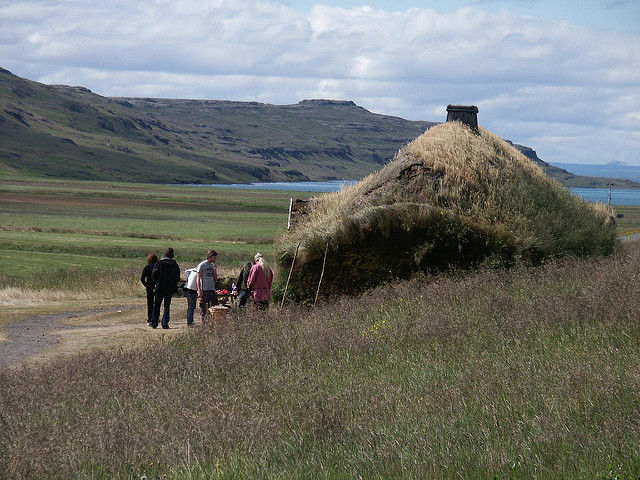
The year of Erik’s birth is not known. His recorded story begins when he arrives in Iceland with his father, Thorvald, from the Jæren district in southwestern Norway. The two had left Norway because of “some killings,” but it is unclear how Erik and Thorvald were involved. Given the date of later events, this incident must have occurred in the 970s. By then, the Viking colony of Iceland already had a substantial population. Because the best areas were populated, and because Thorvald and Erik did not have sufficient influence to gain access to better locations, they settled at Drangar in Hornstrand, on the northern coast of northwestern Iceland. The area was undesirable for farmers like Erik and Thorvald, due to its poor soil quality and short growing season.
Erik made an advantageous marriage to Thjodhild (who some sources refer to as Thorhild), who came from a wealthy family. After his father died, Erik moved farther south to the more inviting region of Breidafjord, where Thjodhild’s stepfather owned a homestead in Haukadalur (Valley of the Hawks). Erik obtained a corner of the estate and established a small farm named Eiríksstaðir. The footprint of a hall believed to have been the home of Erik and his family was fully excavated in 1997–98. Its modest size is an indication of Erik’s relatively low status at this time.
Erik had four children: three sons and one daughter. Thjodhild was the mother of Thorstein and Leif, and she may also have been the mother of Thorvald. Erik’s daughter, Freydis, was born out of wedlock; the name of her mother is unknown.
Exile and Exploration of Greenland
Around the year 980, a dispute broke out between Erik and a neighbour, whom he had lent valuable decorative furnishings called seat-posts. A confrontation between the two men and their supporters resulted in several deaths. For his involvement, Erik was punished with three years of exile. He used the time wisely. Aware that land had been observed west of Iceland by Gunnbjorn Ulf-Krakason about 50 years earlier when his ship was blown off course from Iceland, Erik decided to explore it.
Setting out from Snæfellsnes in western Iceland, Erik first saw land on the east coast of Greenland, at a place later called Blåserk (Black Shirt), probably around modern Ammassalik. Following the coast around the southern tip, he arrived on the much more hospitable western coast. He spent the first winter on an island in the centre of what was later named the Eastern Settlement. During the rest of his exile, he explored much of the Greenlandic coast, recognizing its possibilities for Icelandic-type livestock farming. He named places as he went, claiming ownership of all the land.
Did you know?
While Indigenous peoples did not inhabit southern Greenland at the time of its colonization by the Norse, The Book of Icelanders says that Erik the Red and his party found items left behind by previous Indigenous inhabitants. Among these items were shelters, carved stone and pieces of skin boats.
Erik decided to settle in Eriksfjord (present day Tunulliarfik Fjord) on one of the most promising pieces of land on the inlet, calling it Brattahlíð (“Steep Slope”), which is a reasonable description of the landscape. The area is now called Qassiarsuk.
Although his companions are barely mentioned in the sources, Erik was not alone on his travels. He would have brought a crew of trusted friends and members of his staff with useful skills, such as Thorhall the Hunter. Thorhall was Erik’s hunting steward in the summer and work foreman in the winter.
Founding of the Norse Colony in Greenland
When his three years of exile were up, Erik and his people returned to Breidafjord. Erik declared that he intended to settle permanently in the new country and invited others to come with him. He named the country Greenland, as he felt that an attractive name would entice people to join him. The sagas suggest this was propaganda, but the name is actually fitting for the areas chosen for settlement. They form a striking green contrast to the otherwise barren landscape.
The Saga of the Greenlanders states that 35 ships joined Erik. The Book of Settlements says 25, but both agree that only 14 ships made it to their destination. The rest were either wrecked or storm-driven back to Iceland. This was in either 984 or 985, since the sources place the date of the voyage as 14 or 15 winters before Iceland became Christianized, an event known to have taken place in 999 or 1000. Archaeological evidence has since confirmed that Norse people did indeed settle southern Greenland around this time. They would have primarily been livestock farmers, raising cattle, sheep and goats. The names of nine settlers and the areas given to them by Erik are mentioned in The Saga of the Greenlanders. Their families and staff are rarely mentioned.
Later Life
By establishing himself as the paramount chief of Greenland, Erik gained considerably in status. The Saga of Erik the Red states that “he was held in the highest esteem, and everybody referred to his authority.”
According to some sources, Erik’s son Leif brought Christianity to Greenland around the year 1000. Erik is said to have been much against it, but Thjodhild accepted the new faith and built a small church at Brattahlid. According to The Saga of Olaf Tryggvason, Erik expressed his view that the priest brought to the colony was a swindler, and that by inviting him, his son Leif had committed a negative deed that balanced his good deed in rescuing a shipwrecked crew from death. Although The Saga of the Greenlanders states that Erik never converted to Christianity, The Saga of Erik the Red suggests that he was slow to change his faith, and The Saga of Olaf Tryggvason adds that on Leif’s advice, Erik was baptized together with everyone else in Greenland. It has been severely disputed that Christianity reached Greenland before 1015, but no pagan burials have been found there. Additionally, archaeological evidence from the first settlement indicates that surrounding a small Christian church at Brattahlid was a cemetery where people may have been buried beginning in the 990s. (It is possible that some bodies buried earlier in pagan tradition were exhumed and re-buried at the church.)

When Erik’s son Leif decided to sail west of Greenland to explore what he would later call Vinland (in eastern North America) around the year 1000, Erik at first turned down the opportunity to join, considering himself too old. He later agreed, but ultimately changed his mind again when he perceived bad omens about his involvement in the voyage.
The exact year and circumstances of Erik’s death are unclear. The Saga of the Greenlanders says he died the winter after Leif’s return from Vinland (i.e., around the year 1000) in an epidemic at Brattahlid. According to The Saga of Erik the Red, however, Erik was still living when the explorer Karlesfni sailed to Vinland in the early 11th century, after the epidemic.
Significance
Direct statements attributed to Erik are few in the sagas, but his actions define him. Headstrong and quick to lose his temper, he set his mind to improving his lot and influence. He used his failure in the Icelandic court of law as an opportunity to gain fame and authority by settling and developing a vast land unknown to Europeans, a land that still carries the name he gave it.
His son Leif continued his legacy of exploration by leading some of the first Norse voyages to North America, including Baffin Island, Labrador, Newfoundland and the Maritimes.

 Share on Facebook
Share on Facebook Share on X
Share on X Share by Email
Share by Email Share on Google Classroom
Share on Google Classroom
